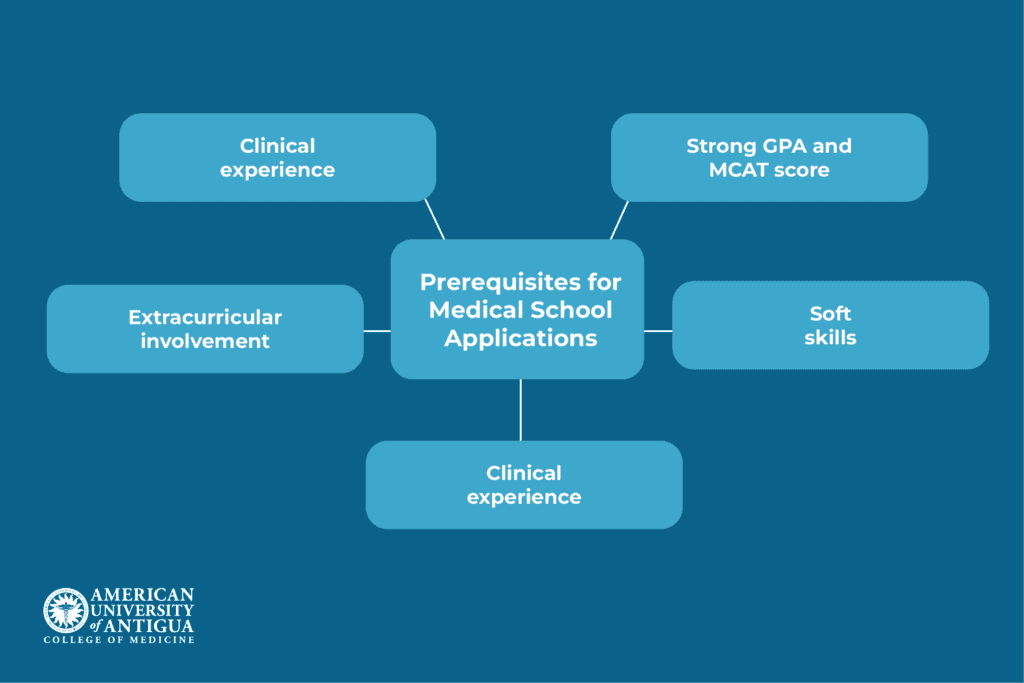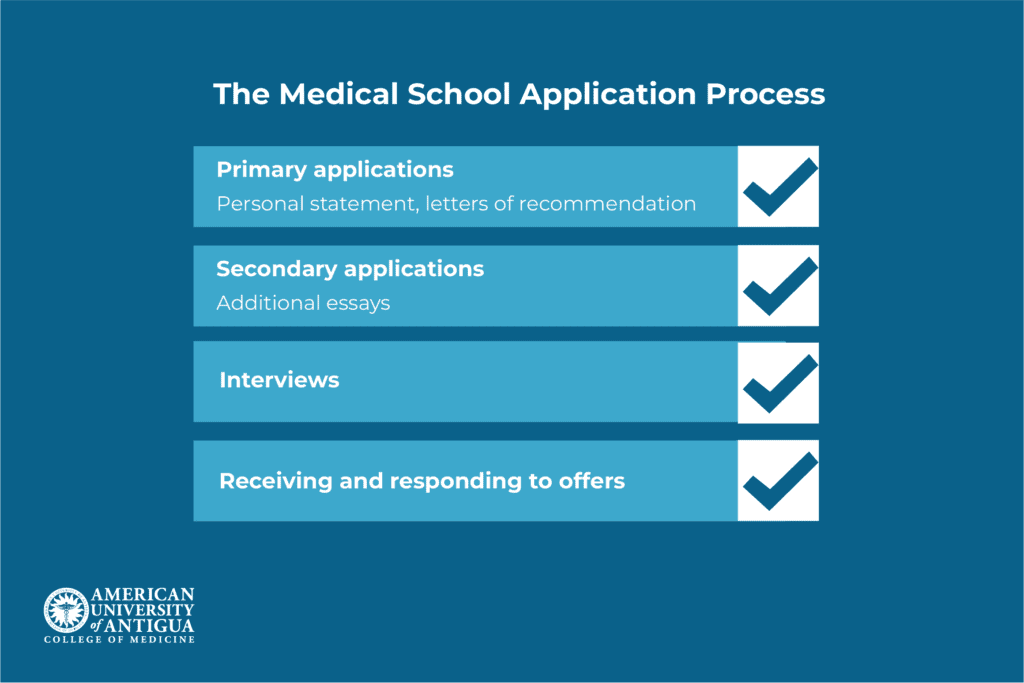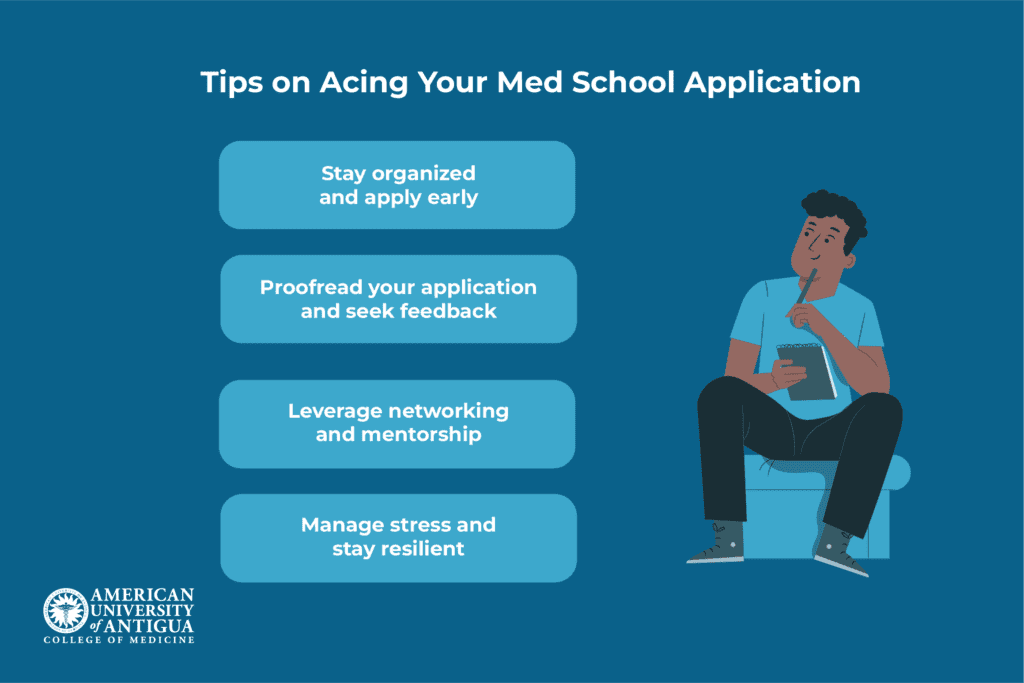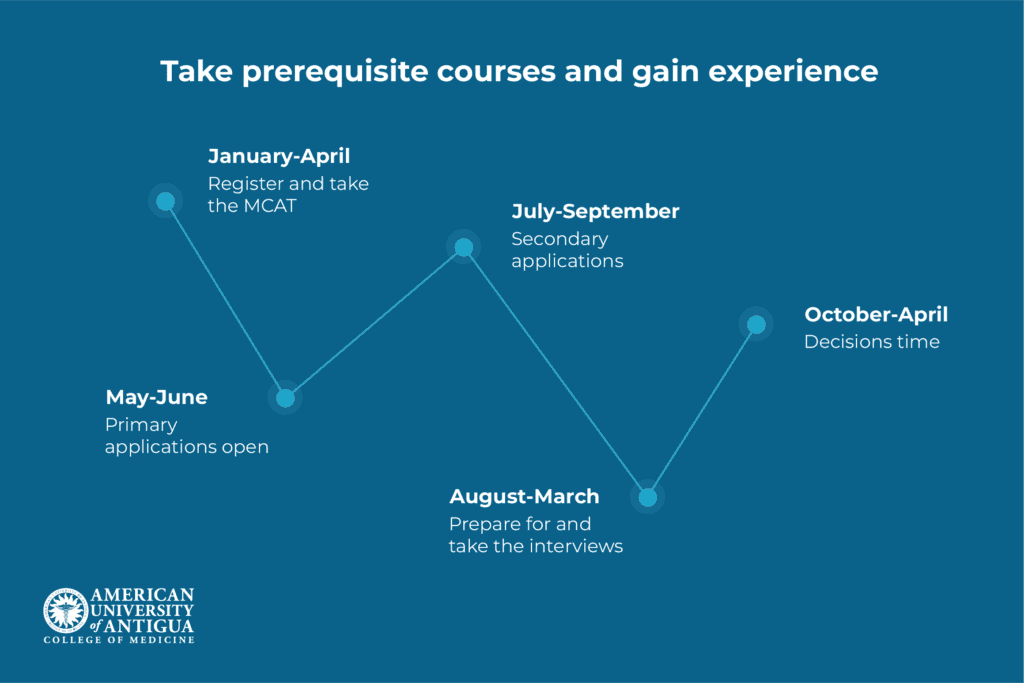Medical School Application Process: Essential Steps & Tips
Key Takeaways
- The medical school application process is highly competitive, including primary and secondary applications, interviews, and responding to offers.
- Early preparation is essential, from crafting strong personal statements to gathering letters of recommendation.
- Staying organized and meeting deadlines is crucial for managing the application process.
Applying to medical school is a thrilling yet challenging endeavor that demands meticulous preparation and commitment. With a growing number of applicants, competition is fierce, making thorough preparation essential to stand out. From crafting compelling essays to preparing for interviews, every detail matters.
In this guide, we’ll walk you through the key steps, share expert tips, and provide a timeline to help you navigate the process with confidence. Whether you’re just starting or approaching submission, this guide will keep you on track to succeed in your medical school journey.
✅ Request information on AUA's MD program TODAY!
Prerequisites for Medical School Applications

Before applying to medical school, it’s essential to meet key prerequisites that demonstrate your readiness for the profession. Most schools require coursework in biology, chemistry, physics, and mathematics, along with a strong GPA and MCAT score.
However, some medical schools, like AUACOM, look beyond academics. A factor that adds value to your application is hands-on clinical experience, such as shadowing doctors, volunteering in hospitals, or working in healthcare settings. Research experience can also strengthen your application by showcasing your ability to analyze data and think critically.
Extracurricular involvement is a significant consideration as well. Leadership roles, community service, and teamwork-based activities highlight qualities like resilience, communication, and empathy – essential traits for future physicians.
Lastly, soft skills are just as important as technical knowledge, as doctors must navigate complex patient interactions and collaborate with diverse healthcare teams.
Meeting these prerequisites not only makes you a stronger applicant but also prepares you for the challenges of medical school and beyond.
Key Steps of the Medical School Application Process
The medical school application process is a comprehensive, multi-step assessment of applicants. It begins with primary applications, where students submit transcripts, personal statements, and MCAT scores. Next come secondary applications, which dive deeper into applicants’ experiences and motivations. Then, medical school interviews evaluate communication skills and fit. Finally, students receive and respond to offers, choosing the best path for their future in medicine.

Step 1: Primary applications
The primary application is your first introduction to medical schools, providing a comprehensive overview of your academics, experiences, and motivations. A strong primary application lays the foundation for success in the admissions process.
Centralized application services
Most medical schools streamline the application process through centralized systems:
- AMCAS (American Medical College Application Service): Used for MD programs
- AACOMAS (American Association of Colleges of Osteopathic Medicine Application Service): Used for DO programs
- TMDSAS (Texas Medical and Dental Schools Application Service): Used specifically for medical schools in Texas
These platforms collect transcripts, MCAT scores, personal statements, and letters of recommendation, before forwarding them to your selected schools.
Personal statement
Your personal statement is an opportunity to showcase why you want to become a doctor. A compelling statement should:
- Highlight meaningful experiences that shaped your passion for medicine
- Use storytelling to engage the reader
- Be authentic and reflective of your journey
Letters of recommendation
Medical schools require letters of recommendation from professors, physicians, or mentors. To secure strong letters, make sure to:
- Seek them from individuals who know you well and can speak to your strengths
- Request them early and provide your resume or personal statement for context
Step 2: Secondary applications
After submitting your primary application, many medical schools request secondary applications, which require additional essays aligned with their values and mission. This step allows schools to assess applicants beyond grades and test scores, considering their personal qualities, motivations, and alignment with the school’s culture.
Secondary essays
These essays provide a deeper look into your experiences, values, and goals. Common prompts include:
- Why this medical school? – Research the school’s mission and connect it to your aspirations
- Describe a challenge you’ve overcome. – Highlight personal growth and resilience
- How will you contribute to diversity in medicine? – Showcase unique perspectives or experiences
Handling multiple applications
Many students receive multiple secondary applications at once, making time management crucial. To stay on track:
- Prioritize schools based on deadlines and preference
- Avoid generic responses – tailor essays to each school
- Maintain consistency in your message while adapting to each prompt
Completing secondary applications efficiently and thoughtfully increases your chances of securing interviews and advancing in the admissions process.
Step 3: Medical school interviews
Medical school interviews assess your communication skills, professionalism, and overall fit for the program. A strong interview performance can make all the difference in securing a medical school acceptance.
Schools use different interview formats, including:
- Traditional interviews – One-on-one or panel-style conversations with faculty members
- Multiple mini interviews (MMI) – A series of short, scenario-based stations that assess critical thinking and ethical reasoning
- Panel interviews – Multiple interviewers evaluating you simultaneously, often including faculty, students, and physicians
To effectively prepare for interviews, follow these tips:
- Research each school to understand its mission, values, and unique programs
- Practice answering common questions, like “Why medicine?” or “Tell me about yourself.”
- Use the STAR method (Situation, Task, Action, Result) to structure responses to behavioral questions
- Prepare ethical scenarios in MMI by discussing dilemmas, showcasing empathy, and demonstrating critical thinking
- Maintain professional etiquette – dress appropriately, be polite, and send thank-you notes after interviews
Step 4: Receiving and responding to offers
After medical school interviews, applicants will receive one of three decisions: acceptance, waitlist, or rejection.
Acceptance
Receiving an acceptance is an exciting and validating achievement! Some schools require a deposit to secure your spot, so be sure to check the deadlines and amount.
Waitlist
If you’re placed on a waitlist, it’s important to remain proactive. Express continued interest by sending an update letter highlighting any new achievements and staying in touch with the admissions office, if allowed. Some schools move students off the waitlist closer to the start of the semester, so keep hope alive.
Rejection
While disappointing, rejection from medical school isn’t the end of your journey. Consider:
- Seeking feedback to understand areas of improvement
- Strengthening your application by gaining more experience, improving your MCAT score, or pursuing additional academic work
- Reapplying – many successful doctors didn’t get in on their first try!
Handling multiple offers
If you receive multiple acceptance offers, you’ll need to choose a medical school and decline others by the school’s deadline. Be mindful of deposit policies and make an informed decision based on factors like curriculum, location, cost, and school culture. Carefully weighing your options and responding in a timely, thoughtful manner will help you make the best choice for your medical career.
Expert Tips for a Successful Medical School Application Process
The road to medical school is filled with challenges, but with the right preparation, you can turn obstacles into stepping stones toward success.

Stay organized and apply early
Medical school applications are rolling, meaning early applicants have an advantage. Keep track of deadlines, required documents, and school-specific requirements to avoid last-minute stress.
Perfect your application and seek feedback
Proofread everything – typos or weak essays can hurt your chances of acceptance. Seek feedback on your personal statement and secondary essays from mentors, professors, or peers to ensure clarity, impact, and authenticity.
Leverage networking and mentorship
Connect with medical students, physicians, or advisors who can share their wisdom and help light the way forward. Strong mentorship can help you navigate the process, avoid pitfalls, and strengthen your application.
Manage stress and stay resilient
The application process can be overwhelming, so take breaks, exercise, and lean on your support system. Remember, setbacks are common, and perseverance is key to achieving your goal. Stay focused, and trust the process!
Medical School Application Timeline
The medical school application process takes over a year, so staying on track is crucial. Here’s a general timeline to guide you through the process:
Key Dates & Milestones
- Fall-Spring (the year before applying): Take prerequisite courses, gain clinical experience, and start MCAT preparation
- January-April: Register and take the MCAT – research schools and request letters of recommendation
- May-June: Primary applications open (AMCAS, AACOMAS, TMDSAS) – apply early for the best chances
- July-September: Secondary applications are sent – respond quickly
- August-March: Interviews take place – be well-prepared and stay engaged with schools
- October-April: Acceptance decisions are sent, waitlist movements occur, and final school selections are made

To make sure you don’t miss a thing, follow this checklist:
- Take the MCAT early
- Request strong letters of recommendation
- Apply as soon as applications open
- Submit secondary essays promptly
- Prepare thoroughly for interviews
- Stay proactive with follow-ups and waitlist updates
What Comes Next?
If you’ve been accepted, congratulations! Now, it’s time to submit any required deposits to secure your spot, complete financial aid paperwork, and prepare for the transition to medical school. Consider finding housing, brushing up on study techniques, and networking with future classmates.
If you’re waitlisted, stay engaged – send a letter of intent, update the school on new achievements, and be patient as waitlist movement happens closer to enrollment.
If you don’t get accepted, don’t lose hope. Evaluate your application to identify areas of improvement and take action to improve. Consider gaining more clinical experience, strengthening your essays, or enrolling in a post-baccalaureate program. Reapplying with a stronger application can significantly increase your chances.
For those exploring other options, careers in healthcare, research, or public health can still lead to meaningful work. Whatever path you choose, stay determined, continue growing, and keep moving forward!
Conclusion
The medical school application process is highly competitive and requires careful planning. From submitting primary and secondary applications to acing interviews, every step plays a vital role in your success. Stay organized, seek feedback, and manage stress to keep your momentum.
If you’re not accepted, take time to strengthen your application and consider reapplying. Remember, it’s a challenging but incredibly rewarding journey, and perseverance is key to reaching your goal.
If you’re still undecided about where to apply, AUACOM offers a unique opportunity to begin your medical career in an enriching and dynamic setting. Apply now and take the first step in this life-changing journey.
Frequently Asked Questions
How long is the medical school application process?
The medical school application process typically spans over a year, starting with MCAT preparation and continuing through application submission, interviews, and decision notifications.
How can you balance your medical school application with studying for the MCAT?
Create a structured schedule that allocates dedicated time for both MCAT preparation and working on your application components, ensuring consistent progress without overwhelming yourself.
How do you choose the right medical school?
Consider factors such as school culture, mission, location, curriculum, and financial aid options to ensure it aligns with your personal goals and aspirations, making it the right medical school for you.
✅ Request information on AUA's MD program TODAY!